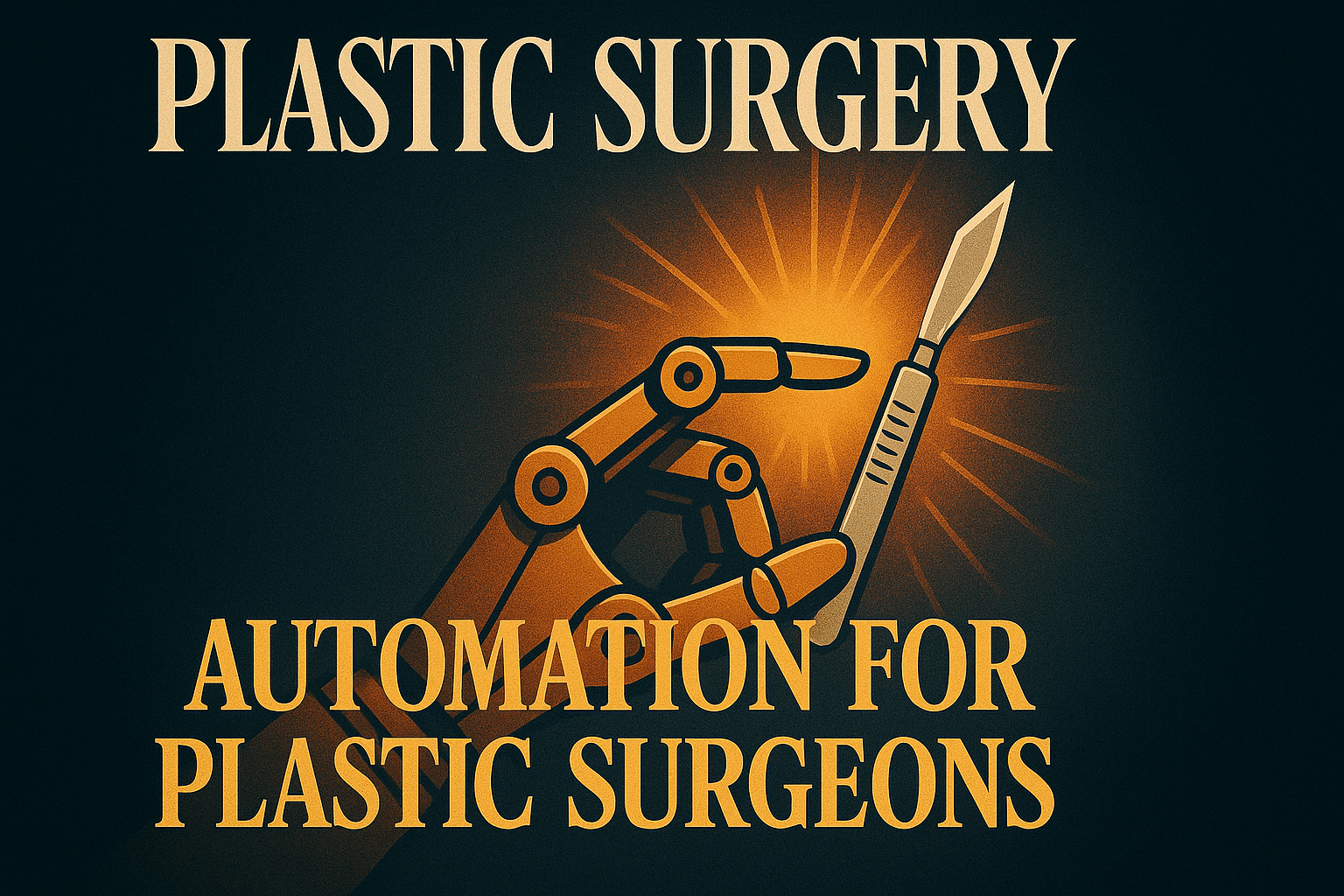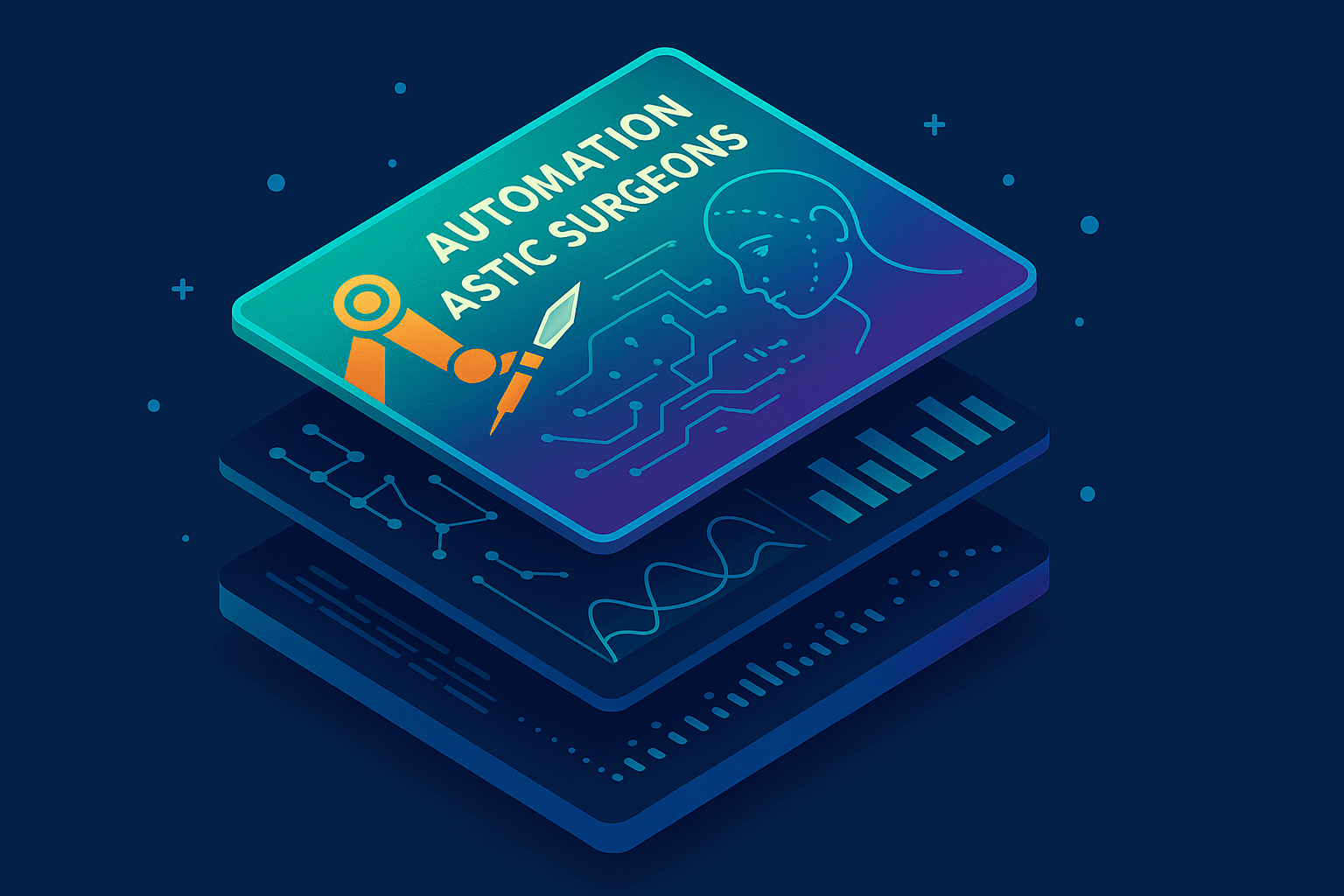Automation for Plastic Surgeons: 7 Proven Strategies to Scale Your Practice in 2026
by Design Delulu Editorial · October 3, 2025

Modern plastic surgery practices face a critical challenge: delivering exceptional patient experiences while managing complex operational workflows. As patient expectations rise and competition intensifies, manual processes create bottlenecks that limit growth and compromise care quality.
Why Automation Matters for Plastic Surgery Practices
The average plastic surgery practice loses 23 hours per week to repetitive administrative tasks—time that could be spent on patient consultations, procedure planning, or business development. Automation transforms these inefficiencies into competitive advantages. When your practice implements intelligent automation systems, you free your team to focus on high-value interactions while technology handles routine workflows seamlessly in the background.
Beyond time savings, automation delivers measurable improvements across every aspect of your practice. Leading plastic surgery practices using comprehensive automation report 40% faster patient response times, 35% higher consultation booking rates, and 50% reduction in administrative overhead. These aren't incremental gains—they're transformational changes that compound over time, creating sustainable competitive moats in increasingly crowded markets.

The 7 Core Automation Plays That Transform Plastic Surgery Practices
1. Intelligent Patient Inquiry Management
Every inquiry represents potential revenue, yet most practices lose 40% of leads within the first 24 hours due to delayed responses. Automated inquiry management systems capture leads from multiple channels—website forms, social media, phone calls—and route them instantly to the appropriate team member with complete context. Smart triage rules ensure rhinoplasty inquiries reach specialists while breast augmentation requests go to the right consultants, all within minutes of initial contact.
2. Consultation Scheduling & Reminder Automation
No-shows and last-minute cancellations cost plastic surgery practices an average of $150,000 annually. Automated scheduling systems integrate with your calendar, send intelligent reminders via SMS and email at optimal intervals, and even handle rescheduling requests through conversational AI. Practices implementing these systems report 68% reduction in no-shows and 45% increase in appointment utilization rates.
3. Pre-Consultation Patient Education Workflows
Educated patients make better decisions and experience higher satisfaction. Automated education sequences deliver procedure-specific information, preparation instructions, and expectation-setting content based on the patient's interests and scheduled procedures. These touchpoints reduce consultation time by 30% while improving patient understanding and confidence.
4. Post-Procedure Follow-Up & Care Coordination
Consistent follow-up care drives better outcomes and higher patient satisfaction scores. Automated post-op workflows send recovery instructions, check-in messages, symptom monitoring questionnaires, and appointment reminders at precise intervals. When responses indicate concerns, the system alerts clinical staff immediately, ensuring no patient falls through the cracks during critical recovery periods.
5. Review Generation & Reputation Management
Online reviews drive 89% of plastic surgery patient decisions, yet most practices struggle with consistent review collection. Automated reputation systems identify satisfied patients at optimal moments—typically 2-4 weeks post-procedure—and send personalized review requests across Google, RealSelf, and other platforms. Top practices using these systems generate 5-7x more reviews than competitors while maintaining 4.8+ star averages.
6. Marketing Attribution & Performance Tracking
Understanding which marketing channels drive actual consultations and procedures remains the biggest challenge in plastic surgery marketing. Advanced automation connects Google Analytics 4, server-side tracking, CRM data, and procedure records into unified dashboards that reveal true ROI. You'll know exactly which Instagram campaigns, SEO keywords, or referral sources generate revenue—not just traffic.
7. Patient Retention & Referral Generation Systems
Acquiring new patients costs 5-7x more than retaining existing ones, yet most practices invest disproportionately in acquisition. Automated retention systems nurture past patients with relevant content about complementary procedures, seasonal promotions, and referral incentives. Sophisticated segmentation ensures breast augmentation patients receive information about maintenance treatments while rhinoplasty patients learn about facial rejuvenation options.

Key Benefits of Comprehensive Automation Systems
- Multi-Channel Patient Journey Tracking: Capture every touchpoint from initial research through procedure completion with event tracking and ecommerce monitoring via GA4 and server-side tagging infrastructure.
- Unified Performance Dashboards: Eliminate data silos with source-of-truth dashboards in Looker Studio that connect marketing spend, lead quality, consultation rates, and procedure revenue in real-time.
- Custom Attribution Modeling: Move beyond last-click attribution with models that accurately reflect your patient journey, whether it's 30-day research cycles or 90-day decision timelines.
- Data Governance & Quality Assurance: Maintain consistent, clean data across all systems with automated validation rules, duplicate detection, and quality monitoring that prevents costly errors.
- Staff Productivity Amplification: Free your team from repetitive tasks so they can focus on high-value patient interactions that only humans can deliver effectively.
- Scalable Growth Infrastructure: Build systems that grow with your practice, handling 10 consultations or 100 with the same level of excellence and attention to detail.
Implementation Framework: From Strategy to Results
Phase 1: Discovery & Strategic Alignment
Successful automation begins with clarity. We map your current patient journey, identify bottlenecks costing you revenue and efficiency, and establish success metrics tied to business outcomes. This phase clarifies which automations deliver maximum ROI for your specific practice context, constraints, and growth objectives. Deliverables include a prioritized automation roadmap and detailed success metrics framework.
Phase 2: Architecture & Blueprint Design
Strategy transforms into actionable plans during the blueprint phase. We design the technical architecture connecting your website, CRM, scheduling system, and marketing platforms. The measurement plan specifies exactly what to track, how to track it, and which dashboards surface the insights you need for daily operations and strategic decisions. This phase prevents costly rework and ensures all systems communicate seamlessly.
Phase 3: Build, Test & Launch
Implementation follows a rigorous build-test-deploy cycle. Each automation undergoes comprehensive QA testing with real-world scenarios before going live. We implement tracking infrastructure, configure integrations, and set up monitoring systems that alert you to issues before they impact patients. Soft launches with controlled rollouts ensure smooth transitions and give your team confidence in new systems.
Phase 4: Optimization & Continuous Improvement
The best automation systems evolve continuously. Post-launch optimization reviews performance data weekly, identifying opportunities to improve conversion rates, reduce friction, and eliminate edge cases. We A/B test messaging, adjust timing and triggers, and refine targeting rules based on actual patient behavior. This iterative approach compounds results—practices see 20-30% additional improvement in the first 90 days post-launch through systematic optimization.
Essential Deliverables for Plastic Surgery Automation
- Comprehensive Tracking Plan: Detailed documentation of all events, conversions, and data points captured across your digital ecosystem with naming conventions and implementation specifications.
- GA4 & Server-Side Tracking Infrastructure: Future-proof analytics setup that maintains accuracy as browser privacy features evolve, with enhanced ecommerce tracking for procedure values and consultation sources.
- Custom Performance Dashboards: Role-specific dashboards for practitioners, practice managers, and marketing teams showing the metrics that matter for each function with automated reporting and alerts.
- Attribution Model Configuration: Custom attribution rules that accurately credit marketing touchpoints based on your typical patient decision journey and buying cycle length.
- Integration Documentation: Complete technical documentation of all system integrations, API connections, and data flows for internal reference and future development.
- Training Resources & Playbooks: Step-by-step guides for your team covering system operation, troubleshooting common issues, and maximizing automation value in daily workflows.

Best Practices for Maximizing Automation ROI
Start with High-Impact, High-Frequency Workflows
Not all automations deliver equal value. Begin with workflows that occur frequently and significantly impact patient experience or practice efficiency. Consultation scheduling, inquiry response, and post-op follow-ups typically deliver the fastest ROI because they touch every patient and directly influence conversion and satisfaction metrics.
Pair Creative Excellence with Measurement Rigor
Automation amplifies results—good or bad. Ensure every automated message, workflow, and campaign meets high creative standards before deployment. Every asset should have clear KPIs tied to business objectives. Beautiful emails that don't convert are just expensive art projects. Measure, iterate, and optimize ruthlessly.
Build with Templates and Scalable Systems
Design automation components for reuse and adaptation. Template structures for email sequences, SMS campaigns, and workflow logic that can be customized for different procedures, patient segments, or seasonal campaigns. This approach accelerates deployment and maintains consistency as your practice grows.
Establish Review Cadences and Feedback Loops
Weekly operational reviews keep automations performing optimally and identify emerging issues quickly. Quarterly strategic reviews assess whether systems align with evolving business priorities and reveal opportunities for expansion. Close feedback loops between clinical staff, administrative teams, and technology systems ensure automations enhance rather than complicate workflows.
Maintain Human Touch in Automated Communications
The best automation feels personal, not robotic. Use dynamic content, behavioral triggers, and segmentation to deliver relevant, timely messages that feel like they're from a team member who knows the patient. Always provide easy escalation paths to human support when automated systems can't fully address patient needs.
Industry-Specific Strategies for Plastic Surgery Practices
Map Content to Patient Decision Stages
Plastic surgery purchases involve extended research and consideration periods. Structure automation sequences around the typical journey: awareness (procedure education), consideration (provider selection criteria), decision (consultation booking), and retention (post-procedure care and additional services). Different procedures have different cycles—understand these nuances and customize accordingly.
Leverage Social Proof Throughout the Journey
Patient testimonials, before-and-after galleries, and review highlights build trust and accelerate decisions. Integrate social proof into automated workflows strategically—early touchpoints establish credibility while pre-consultation messages reinforce confidence. Video testimonials from patients with similar concerns create powerful connection and overcome final hesitations.
Create Single Source of Truth Dashboards
Multiple systems create confusion and misalignment. Consolidate data from your website, CRM, scheduling platform, and marketing channels into unified dashboards that everyone references. When your team operates from shared truth, decisions improve and execution accelerates. Eliminate the weekly data reconciliation meetings that waste valuable time.
Embrace Rapid Experimentation Cycles
The practices winning market share test constantly. Ship small improvements weekly rather than waiting for perfect comprehensive launches. A/B test email subject lines, SMS timing, landing page layouts, and call-to-action language. Small wins compound into significant advantages—a practice improving conversion by 2% monthly grows revenue 27% annually through optimization alone.
Prioritize Mobile Experience and Speed
Over 70% of plastic surgery research happens on mobile devices. Ensure every automated touchpoint—emails, SMS messages, landing pages, booking forms—delivers flawless mobile experiences with fast load times. Mobile-optimized systems capture leads competitors lose to friction and frustration.
Frequently Asked Questions
Let’s level up your Plastic Surgeons business
Need services that actually move the needle for Plastic Surgeons? See our approach, pricing, and timelines—then book a quick call.
Additional Resources
- Schedule Your Free Automation Strategy Call
Book a 30-minute consultation to discuss your practice's specific automation opportunities. We'll identify your highest-ROI automation plays and outline a custom implementation roadmap tailored to your goals.
- View Our Plastic Surgery Portfolio & Case Studies
Explore real-world examples of automation systems we've built for plastic surgery practices, including performance metrics, implementation timelines, and ROI data from practices similar to yours.
- Free Practice Growth Tools & Resources
Access our collection of free tools including automation readiness assessments, ROI calculators, patient journey mapping templates, and comprehensive guides for plastic surgery practice growth.
Related Reading

Discover how automation for electricians streamlines scheduling, invoicing, lead tracking, and customer follow-ups to boost revenue and efficiency. Get started today.

Discover how automation streamlines furniture & home decor operations with GA4 tracking, attribution modeling, and data-driven dashboards. Get your 90-day implementation roadmap.
